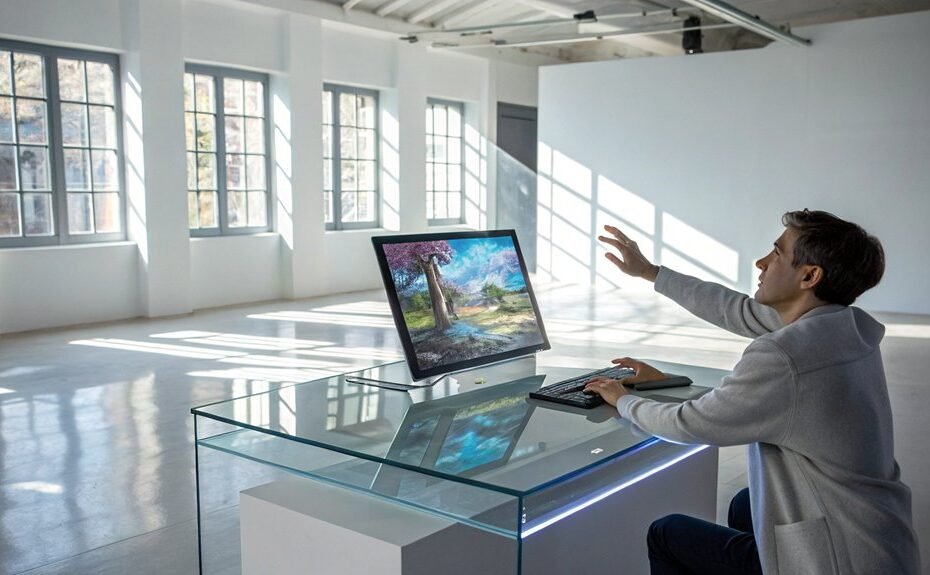Google's AI Image Generator requires users to enroll through Google Search Labs and is available to U.S. residents 18 and older. The system processes English-language text prompts to create four distinct images per request, with new users receiving two free weekly trials. Features include image editing, upscaling capabilities, and integration with Google Workspace applications. Content policies guarantee safety through metadata tracking and watermarking. Further exploration reveals advanced customization options for professional applications.
Google's artificial intelligence image generator, integrated into the Search Generative Experience (SGE), permits users to create custom images through text prompts directly within Google Search and Google Images. The platform, available to users in the United States who opt in through Google Search Labs, requires participants to be 18 years or older and currently supports English language inputs exclusively.
To access the image generation capabilities, users must first join the SGE program through Google Search Labs. Once enrolled, they can input text descriptions to generate images, with the system typically providing four distinct options for each prompt. The platform incorporates natural language processing to guarantee precise control over image creation, while maintaining strict safety guidelines to prevent misuse. Similar to MimicPC Realistic AI Image Generator, the platform offers two free trials weekly for new users to explore its capabilities.
Google's SGE program enables users to create AI-generated images through text prompts, delivering multiple options while ensuring safety standards.
The technology is powered by Imagen AI, which allows users to not only generate new images but additionally edit existing ones through masking features. Like Microsoft's Image Creator, users receive daily generation boosts to expedite their creative process. Advanced users can utilize upscaling capabilities and fine-tune their creations, while the system's integration with Google Lens improves product search functionality based on generated images.
All AI-generated content includes metadata and invisible watermarking to guarantee transparency and accountability. The platform's technical infrastructure utilizes the Gemini 2.0 Flash model, combining multimodal input processing with improved reasoning capabilities.
Users can export their creations to Google Workspace applications or save them directly to Google Drive, facilitating seamless integration with other Google services. The system's content creation policies actively block the generation of explicit material, misinformation, and illegal content, unless specifically labeled for educational or artistic purposes.
Professional applications benefit from improved resolution options and detailed control over image characteristics. The platform supports iterative refinement through user feedback, allowing for precise adjustments to meet specific creative requirements.
Integration with Google AI Studio enables developers to experiment with advanced features and customize the generation process according to their needs. The system's capabilities extend to generating new backgrounds for product images and maintaining consistent character appearances across multiple iterations.
Users can preserve specific styles or subject characteristics while modifying other elements of their images. This flexibility, combined with the platform's robust safety measures and professional features, positions Google's AI image generator as a versatile tool for both casual users and professionals requiring high-quality visual content generation.
Most-Asked Questions FAQ
Can I Sell or Monetize Images Created With Google's AI Generator?
Users can monetize AI-generated images through various channels like digital art sales, social media content, freelance services, stock photos, and print-on-demand products, following platform guidelines.
What Happens to My Uploaded Reference Images After Generating New Ones?
Reference images remain stored in Google's asset library until manually deleted by users. They're accessible through the Google Ads platform while following data privacy and security protocols.
How Does Google's AI Generator Compare to Midjourney and DALL-E?
Google's AI generator excels in text rendering and sequential images, while Midjourney specializes in realistic visuals, and DALL-E offers versatile artistic styles. Each platform provides unique strengths for different creative needs.
Are There Restrictions on Generating Images Containing Trademarked Content?
Google's AI image generator strictly prohibits generating trademarked content, including logos and brand elements. These restrictions protect brands from unauthorized use and prevent potential legal issues with trademark infringement.
Can I Edit or Modify Ai-Generated Images After They're Created?
AI-generated images can be modified through text prompts, mask-based editing, and conversational features. Tools like Imagen 3 and Gemini 2.0 Flash support post-generation customization and refinements.
